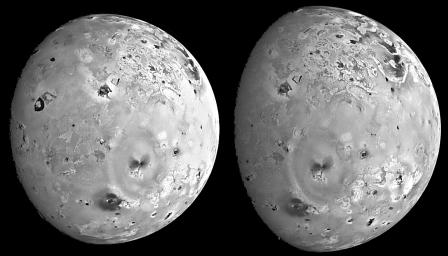
|
Mountains and Plateaus on Io
- Click the image above for a larger view
- Full-Res JPEG (1152 x 659) (106.4 kB)
- Full-Res TIFF (1152 x 659) (592.9 kB)
Caption:
These two views of Io were acquired by NASA's Galileo spacecraft during its seventh orbit (G7) of Jupiter. The images were designed to view large features on Io at low sun angles when the lighting conditions emphasize the topography or relief of the volcanic satellite. Sun angles are low near the terminator which is the day-night boundary near the left side of the images. These images reveal that the topography is very flat near the active volcanic centers such as Loki Patera (the large dark horseshoe-shaped feature near the terminator in the left-hand image) and that a variety of mountains and plateaus exist elsewhere.
North is to the top of the picture. The resolution is about 6 kilometers per picture element (6.1 for the left hand image and 5.7 for the right). The images were taken on April 4th, 1997 at a ranges of 600,000 kilometers (left image) and 563,000 kilometers (right image) by the solid state imaging (CCD) system on NASA's Galileo spacecraft.
Background Info:
The Jet Propulsion Laboratory, Pasadena, CA manages the mission for NASA's Office of Space Science, Washington, DC.
This image and other images and data received from Galileo are posted on the World Wide Web, on the Galileo mission home page at URL http://galileo.jpl.nasa.gov. Background information and educational context for the images can be found at http://www.jpl.nasa.gov/galileo/sepo .
Cataloging Keywords:
| Name | Value | Additional Values |
|---|---|---|
| Target | Io | Jupiter |
| System | Jupiter | |
| Target Type | Satellite | Planet |
| Mission | Galileo | |
| Instrument Host | Galileo Orbiter | |
| Host Type | Orbiter | |
| Instrument | Solid-State Imaging (SSI) | |
| Detector | ||
| Extra Keywords | Grayscale, Mountain, Volcano | |
| Acquisition Date | ||
| Release Date | 1998-03-26 | |
| Date in Caption | ||
| Image Credit | NASA/JPL/University of Arizona | |
| Source | photojournal.jpl.nasa.gov/catalog/PIA01218 | |
| Identifier | PIA01218 | |
